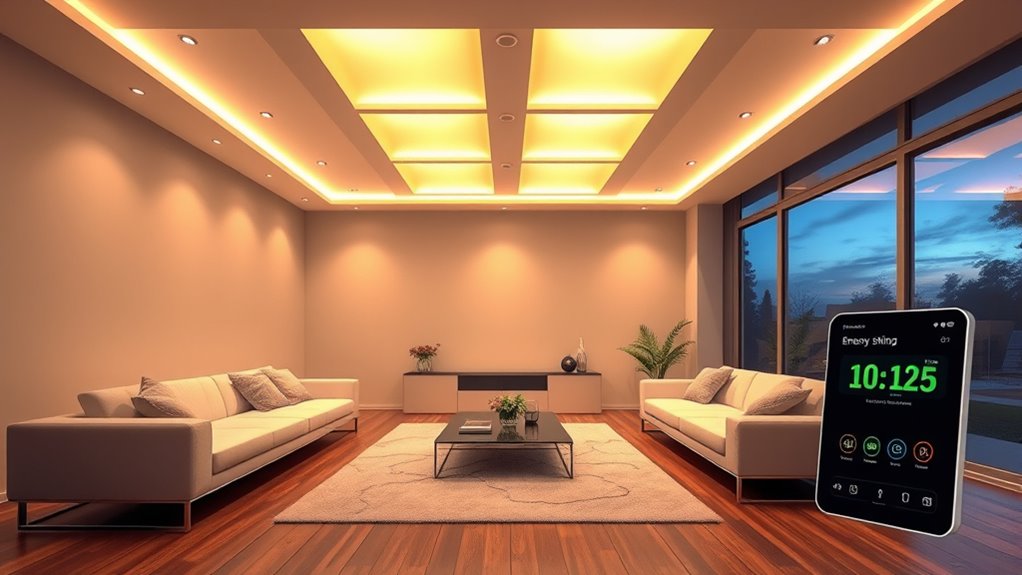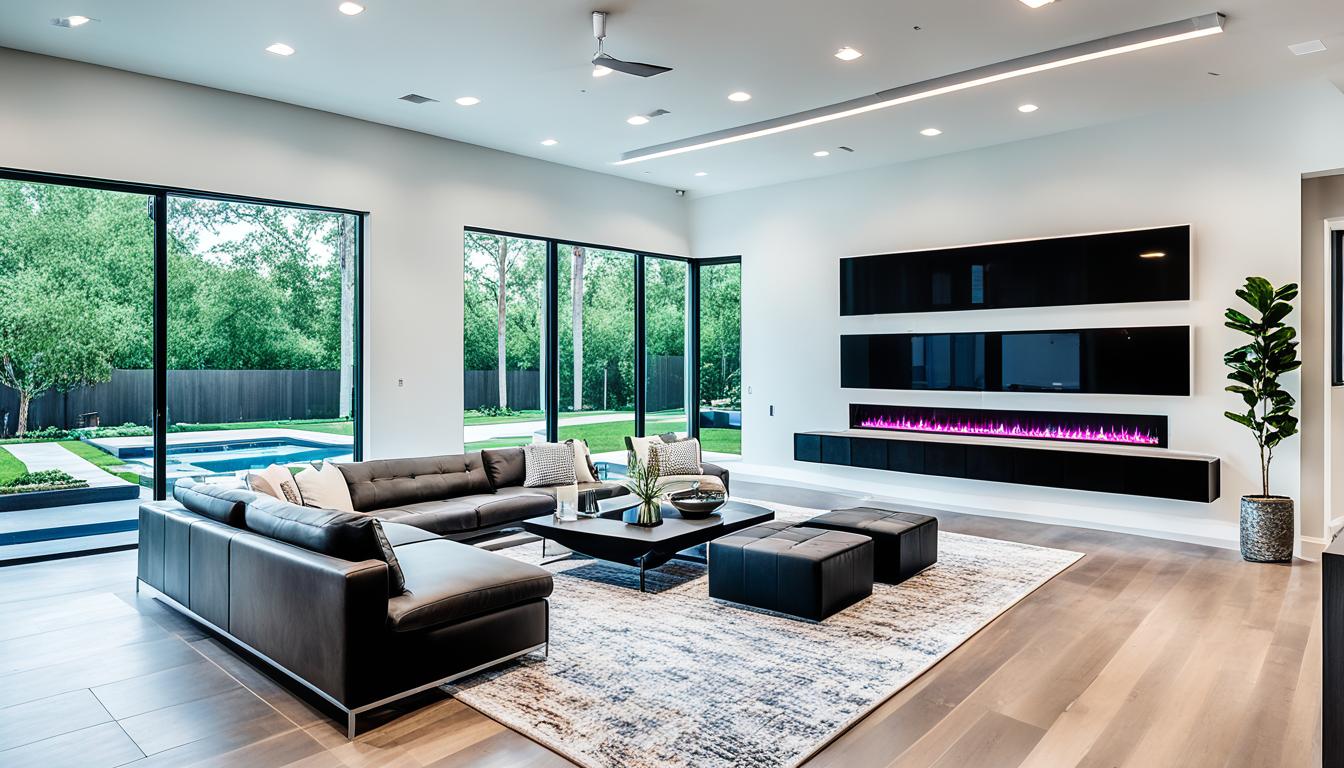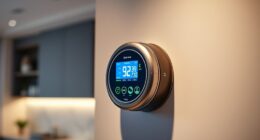Using smart lighting helps you cut energy consumption by automatically adjusting lights based on movement and natural light levels. Motion sensors turn lights on when you enter and off after a set time, so you don’t waste energy. Daylight harvesting dim or switch off lights when sunlight is enough, keeping energy use minimal. Combining both technologies creates an efficient system that saves money and supports sustainability. Keep exploring to discover how these systems can power your space smarter.
Key Takeaways
- Implement motion sensors to automatically turn lights on when entering and off after inactivity, reducing unnecessary energy use.
- Use daylight harvesting sensors to dim or switch off lights based on natural light levels, conserving electricity during daylight hours.
- Combine motion detection with daylight harvesting for an adaptive system that optimizes lighting and minimizes waste.
- Adopt smart lighting systems that learn user habits to further enhance energy savings and automate adjustments.
- Upgrade to intelligent lighting solutions to continuously improve efficiency and support sustainable energy management practices.

Smart lighting systems are revolutionizing how we reduce energy consumption in homes and businesses. With the integration of advanced technology, you now have tools that automatically adapt to your environment, saving energy without sacrificing comfort or convenience. One of the key features making this possible is motion sensors. These sensors detect movement in a room and turn lights on or off accordingly. When you enter a space, the lights activate instantly, and when you leave, they switch off after a set period of inactivity. This prevents lights from being left on unnecessarily, which is a common source of wasted energy. Over time, this simple automation can drastically cut your electricity bills and reduce your carbon footprint. Motion sensors are especially effective in areas like hallways, bathrooms, and conference rooms where lights are often left on without anyone present.
Another powerful aspect of smart lighting is daylight harvesting, a technique that adjusts artificial lighting based on the amount of natural light available. This feature uses sensors to monitor sunlight levels through windows and skylights, then dims or turns off electric lights when there’s enough daylight to illuminate the space adequately. If the sun is shining brightly outside, your smart system will reduce reliance on indoor lighting, conserving energy without you needing to do a thing. During cloudy days or evenings, the system increases artificial lighting to maintain a consistent brightness. Daylight harvesting ensures you’re using only the necessary amount of electricity, which not only lowers energy costs but also minimizes waste. This approach is particularly beneficial in large commercial spaces with abundant natural light, but it can be equally effective in residential settings.
Together, motion sensors and daylight harvesting create a highly efficient lighting environment that responds to your needs automatically. You don’t have to remember to switch lights on or off, nor do you need to manually adjust brightness levels throughout the day. Instead, your smart lighting system learns and adapts to your habits and the environment, optimizing energy use constantly. This not only helps you save money but also supports sustainability efforts by reducing unnecessary energy consumption. Installing smart lighting with these features is a wise move for anyone interested in reducing their environmental impact while enjoying the benefits of modern convenience. As technology advances, these systems will become even smarter, further streamlining energy management and making it easier than ever to be eco-friendly in your everyday life. Understanding how home automation enhances energy efficiency can help you make better choices for your space.
Frequently Asked Questions
How Cost-Effective Is Smart Lighting Installation Long-Term?
Smart lighting installation is generally cost-effective in the long term. You should perform a cost analysis and ROI calculation to determine savings from reduced energy bills and maintenance costs. While initial expenses can be high, the energy efficiency and automation features quickly offset upfront costs. Over time, you’ll see significant savings, making smart lighting a smart investment for your home or business.
Can Smart Lighting Systems Be Integrated With Existing Home Automation?
Smart lighting systems are like the backbone of your home automation, seamlessly integrating with existing setups. You can easily connect them using voice control or remote access, making your life more convenient. Most systems are designed for compatibility, so you won’t hit a wall trying to mesh new tech with your current automation. This means you can enjoy smarter lighting without needing a complete overhaul, just a simple, harmonious upgrade.
What Maintenance Is Required for Smart Lighting Devices?
You should regularly check your smart lighting devices for dust or dirt, which can affect performance. Replace bulbs before their lifespan ends to maintain ideal brightness and efficiency. Keep firmware updated to prevent glitches, and follow a maintenance schedule that includes cleaning and inspections. This way, you ensure your smart lighting remains reliable, extends its lifespan, and continues saving energy effectively.
Are There Privacy Concerns With Smart Lighting Data Collection?
Privacy concerns with smart lighting data collection are like shadows in the night—you need to stay vigilant. You might worry about data security and who accesses your information. While smart lighting offers energy savings, it can collect data on your habits. To stay safe, make sure your devices have strong security features, update software regularly, and understand what data is being gathered to protect your privacy.
How Quickly Can Energy Savings Be Observed After Installation?
You can see instant savings and quick results immediately after installing smart lighting. As soon as you start using automated controls and dimming features, your energy consumption drops. You won’t need to wait weeks or months; the benefits begin right away. Smart lighting adjusts to your habits, ensuring efficient use of energy from the moment it’s operational, helping you save on costs almost instantly.
Conclusion
So, here you are, saving energy with smart lighting, yet you’re left pondering if your electric bill will thank you or if the smart bulbs will start plotting their own agenda. Ironically, while these lights turn off when you forget, they’re secretly shining a light on the fact that even the simplest tech can make a big difference. Who knew that flickering a switch could brighten your savings — and maybe, just maybe, your future?








